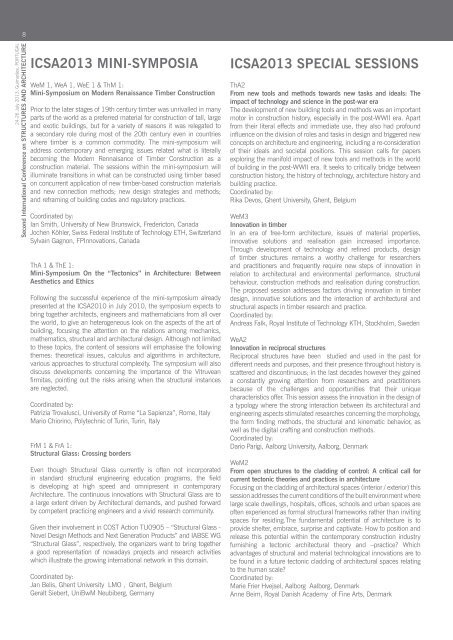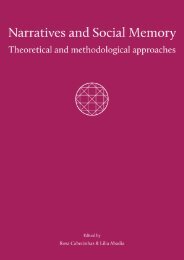Second International Conference on STRUCTURES AND ...
Second International Conference on STRUCTURES AND ...
Second International Conference on STRUCTURES AND ...
You also want an ePaper? Increase the reach of your titles
YUMPU automatically turns print PDFs into web optimized ePapers that Google loves.
8<br />
24-26 July 2013, Guimarães, PORTUGAL<br />
<str<strong>on</strong>g>Sec<strong>on</strong>d</str<strong>on</strong>g> <str<strong>on</strong>g>Internati<strong>on</strong>al</str<strong>on</strong>g> <str<strong>on</strong>g>C<strong>on</strong>ference</str<strong>on</strong>g> <strong>on</strong> <strong>STRUCTURES</strong> <strong>AND</strong> ARCHITECTURE<br />
ICSA2013 MINI-SYMPOSIA<br />
WeM 1, WeA 1, WeE 1 & ThM 1:<br />
Mini-Symposium <strong>on</strong> Modern Renaissance Timber C<strong>on</strong>structi<strong>on</strong><br />
Prior to the later stages of 19th century timber was unrivalled in many<br />
parts of the world as a preferred material for c<strong>on</strong>structi<strong>on</strong> of tall, large<br />
and exotic buildings, but for a variety of reas<strong>on</strong>s it was relegated to<br />
a sec<strong>on</strong>dary role during most of the 20th century even in countries<br />
where timber is a comm<strong>on</strong> commodity. The mini-symposium will<br />
address c<strong>on</strong>temporary and emerging issues related what is literally<br />
becoming the Modern Rennaisance of Timber C<strong>on</strong>structi<strong>on</strong> as a<br />
c<strong>on</strong>structi<strong>on</strong> material. The sessi<strong>on</strong>s within the mini-symposium will<br />
illuminate transiti<strong>on</strong>s in what can be c<strong>on</strong>structed using timber based<br />
<strong>on</strong> c<strong>on</strong>current applicati<strong>on</strong> of new timber-based c<strong>on</strong>structi<strong>on</strong> materials<br />
and new c<strong>on</strong>necti<strong>on</strong> methods; new design strategies and methods;<br />
and reframing of building codes and regulatory practices.<br />
Coordinated by:<br />
Ian Smith, University of New Brunswick, Frederict<strong>on</strong>, Canada<br />
Jochen Köhler, Swiss Federal Institute of Technology ETH, Switzerland<br />
Sylvain Gagn<strong>on</strong>, FPInnovati<strong>on</strong>s, Canada<br />
ThA 1 & ThE 1:<br />
Mini-Symposium On the “Tect<strong>on</strong>ics” in Architecture: Between<br />
Aesthetics and Ethics<br />
Following the successful experience of the mini-symposium already<br />
presented at the ICSA2010 in July 2010, the symposium expects to<br />
bring together architects, engineers and mathematicians from all over<br />
the world, to give an heterogeneous look <strong>on</strong> the aspects of the art of<br />
building, focusing the attenti<strong>on</strong> <strong>on</strong> the relati<strong>on</strong>s am<strong>on</strong>g mechanics,<br />
mathematics, structural and architectural design. Although not limited<br />
to these topics, the c<strong>on</strong>tent of sessi<strong>on</strong>s will emphasise the following<br />
themes: theoretical issues, calculus and algorithms in architecture,<br />
various approaches to structural complexity. The symposium will also<br />
discuss developments c<strong>on</strong>cerning the importance of the Vitruvean<br />
firmitas, pointing out the risks arising when the structural instances<br />
are neglected.<br />
Coordinated by:<br />
Patrizia Trovalusci, University of Rome “La Sapienza”, Rome, Italy<br />
Mario Chiorino, Polytechnic of Turin, Turin, Italy<br />
FrM 1 & FrA 1:<br />
Structural Glass: Crossing borders<br />
Even though Structural Glass currently is often not incorporated<br />
in standard structural engineering educati<strong>on</strong> programs, the field<br />
is developing at high speed and omnipresent in c<strong>on</strong>temporary<br />
Architecture. The c<strong>on</strong>tinuous innovati<strong>on</strong>s with Structural Glass are to<br />
a large extent driven by Architectural demands, and pushed forward<br />
by competent practicing engineers and a vivid research community.<br />
Given their involvement in COST Acti<strong>on</strong> TU0905 – “Structural Glass -<br />
Novel Design Methods and Next Generati<strong>on</strong> Products” and IABSE WG<br />
“Structural Glass”, respectively, the organizers want to bring together<br />
a good representati<strong>on</strong> of nowadays projects and research activities<br />
which illustrate the growing internati<strong>on</strong>al network in this domain.<br />
Coordinated by:<br />
Jan Belis, Ghent University LMO , Ghent, Belgium<br />
Geralt Siebert, UniBwM Neubiberg, Germany<br />
ICSA2013 SPECIAL SESSIONS<br />
ThA2<br />
From new tools and methods towards new tasks and ideals: The<br />
impact of technology and science in the post-war era<br />
The development of new building tools and methods was an important<br />
motor in c<strong>on</strong>structi<strong>on</strong> history, especially in the post-WWII era. Apart<br />
from their literal effects and immediate use, they also had profound<br />
influence <strong>on</strong> the divisi<strong>on</strong> of roles and tasks in design and triggered new<br />
c<strong>on</strong>cepts <strong>on</strong> architecture and engineering, including a re-c<strong>on</strong>siderati<strong>on</strong><br />
of their ideals and societal positi<strong>on</strong>s. This sessi<strong>on</strong> calls for papers<br />
exploring the manifold impact of new tools and methods in the world<br />
of building in the post-WWII era. It seeks to critically bridge between<br />
c<strong>on</strong>structi<strong>on</strong> history, the history of technology, architecture history and<br />
building practice.<br />
Coordinated by:<br />
Rika Devos, Ghent University, Ghent, Belgium<br />
WeM3<br />
Innovati<strong>on</strong> in timber<br />
In an era of free-form architecture, issues of material properties,<br />
innovative soluti<strong>on</strong>s and realisati<strong>on</strong> gain increased importance.<br />
Through development of technology and refined products, design<br />
of timber structures remains a worthy challenge for researchers<br />
and practiti<strong>on</strong>ers and frequently require new steps of innovati<strong>on</strong> in<br />
relati<strong>on</strong> to architectural and envir<strong>on</strong>mental performance, structural<br />
behaviour, c<strong>on</strong>structi<strong>on</strong> methods and realisati<strong>on</strong> during c<strong>on</strong>structi<strong>on</strong>.<br />
The proposed sessi<strong>on</strong> addresses factors driving innovati<strong>on</strong> in timber<br />
design, innovative soluti<strong>on</strong>s and the interacti<strong>on</strong> of architectural and<br />
structural aspects in timber research and practice.<br />
Coordinated by:<br />
Andreas Falk, Royal Institute of Technology KTH, Stockholm, Sweden<br />
WeA2<br />
Innovati<strong>on</strong> in reciprocal structures<br />
Reciprocal structures have been studied and used in the past for<br />
different needs and purposes, and their presence throughout history is<br />
scattered and disc<strong>on</strong>tinuous; in the last decades however they gained<br />
a c<strong>on</strong>stantly growing attenti<strong>on</strong> from researchers and practiti<strong>on</strong>ers<br />
because of the challenges and opportunities that their unique<br />
characteristics offer. This sessi<strong>on</strong> assess the innovati<strong>on</strong> in the design of<br />
a typology where the str<strong>on</strong>g interacti<strong>on</strong> between its architectural and<br />
engineering aspects stimulated researches c<strong>on</strong>cerning the morphology,<br />
the form finding methods, the structural and kinematic behavior, as<br />
well as the digital crafting and c<strong>on</strong>structi<strong>on</strong> methods.<br />
Coordinated by:<br />
Dario Parigi, Aalborg University, Aalborg, Denmark<br />
WeM2<br />
From open structures to the cladding of c<strong>on</strong>trol: A critical call for<br />
current tect<strong>on</strong>ic theories and practices in architecture<br />
Focusing <strong>on</strong> the cladding of architectural spaces (interior / exterior) this<br />
sessi<strong>on</strong> addresses the current c<strong>on</strong>diti<strong>on</strong>s of the built envir<strong>on</strong>ment where<br />
large scale dwellings, hospitals, offices, schools and urban spaces are<br />
often experienced as formal structural frameworks rather than inviting<br />
spaces for residing.The fundamental potential of architecture is to<br />
provide shelter, embrace, surprise and captivate: How to positi<strong>on</strong> and<br />
release this potential within the c<strong>on</strong>temporary c<strong>on</strong>structi<strong>on</strong> industry<br />
furnishing a tect<strong>on</strong>ic architectural theory and –practice Which<br />
advantages of structural and material technological innovati<strong>on</strong>s are to<br />
be found in a future tect<strong>on</strong>ic cladding of architectural spaces relating<br />
to the human scale<br />
Coordinated by:<br />
Marie Frier Hvejsel, Aalborg Aalborg, Denmark<br />
Anne Beim, Royal Danish Academy of Fine Arts, Denmark

















